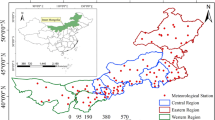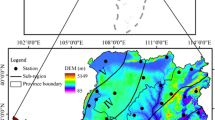Abstract
Evapotranspiration is an important flux term in the water cycle that integrates atmospheric demand and surface conditions. Using the FAO Penman–Monteith method, we calculated monthly reference evapotranspiration (ET0) for 119 stations during 1961–2004 over Yunnan Province (YP), southwest China. Linear trend analysis shows that area-averaged annual and seasonal ET0 rates declined, with most remarkable decreases during pre-monsoon (−1.5 mm decade−1, Mar–May) and monsoon (−0.6 mm decade−1, Jun–Aug) seasons. Most of the stations with negative trends were concentrated in the eastern and northern parts of YP. Over the 44–year period, wind speed (WS), relative sunshine duration (SD) and relative humidity (RH) all showed decreasing trends, whereas maximum temperature (TMX) increased slightly. Multivariate regression analysis indicated that the variability of ET0 rates is most sensitive to the variations of SD, followed by RH, TMX and WS. The temporal evolution of these contributing factors was not stable during the study period, with an increasing contribution of SD and a decreasing contribution of TMX after the 1970s. Temporally changing contributions of climatic variables to ET0 should be taken into account when evapotranspiration rates are calculated with equations that rely on parameterization of climatic variables. Linking the changing contributions of climatic variables to ET0 rates to circulation features may help to better understand how ET0 responds to regional climatic change.






Similar content being viewed by others
References
Allen RG, Pereira LS, Raes D, Smith M (1998) Crop evapotranspiration – Guidelines for computing crop water requirements. FAO Irrigation and Drainage Paper 56. Food and Agriculture Organization, Rome, Italy.
Ångström A (1924) Solar and terrestrial radiation. Quart J Roy Meteorol Soc 50:121–125
Chattopadhyay N, Hulme M (1997) Evaporation and potential evapotranspiration in India under conditions of recent and future climatic change. Agr Forest Meteorol 87(1):55–74
Chen S, Liu Y, Thomas A (2006) Climatic change on the Tibetan Plateau: potential evapotranspiration trends from 1961–2000. Clim Chang 76(3–4):291–319
Doorenbos J, Pruitt WO (1977) Guidelines for predicting crop water requirements, FAO Irrigation and Drainage Paper 24. Food and Agriculture Organization of the United Nations, Rome
Fan Z, Bräuning A, Thomas A, Li J, Cao K (2011) Spatial and temporal temperature trends on the Yunnan Plateau (Southwest China) during 1961–2004. Int J Climatol 31(14):2078–2090
Fisher JB, Whittaker RJ, Malhi Y (2011) ET come home: potential evapotranspiration in geographical ecology. Global Ecol Biogeogr 20:1–18
Gao G, Chen D, Ren G, Chen Y, Liao Y (2006) Spatial and temporal variations and controlling factors of potential evapotranspiration in China: 1956–2000. J Geograph Sci 16(1):3–12
Guo H, Xu M, Hu Q (2011) Changes in near-surface wind speed in China: 1969–2005. Int J Climatol 31(3):349–358
Hamon WR (1963) Computation of direct runoff amounts from storm rainfall. Int Assn of Sci Hydrol Publ 63:52–62
Hannachi A, Jolliffe IT, Stephenson DB (2009) Empirical orthogonal functions and related techniques in atmospheric science: a review. Int J Climatol 27(9):1119–1152
Hargreaves GH (1974) Estimation of potential and crop evapotranspiration. Trans ASAE 17:701–704
Haude W (1954) Zur praktischen Bestimmung der aktuellen und potentiellen Evaporation und Evapotranspiration. Mitteilungen des Deutschen Wetterdienstes 8:81–94 (in German)
Hess TM (2002) AWSET software for evapotranspiration calculation V3. Cranfield University, UK. http://www.cranfield.ac.uk/sas/naturalresources/research/projects/awset.html. Accessed 20 December 2010
Huntington TG (2006) Evidence for intensification of the global water cycle: review and synthesis. J Hydrol 319:83–95
IPCC (2007) Summary for policymakers. In: Solomon S, Qin D, Manning M, Chen Z, Marquis M, Averyt K, Tignor M, Miller HL (eds) Climate change 2007: the physical science basis. Contribution of working group I to the Forth Assessment Report of the Intergovernmental Panel on Climate Change. Cambridge University Press, Cambridge, pp 1–18
Jensen ME, Burman RD, Allen RG (1990) Evaporation and irrigation water requirements. ASCE Manuals and Reports on Engineering Practices No.70. American Society of Civil Engineers, New York
Li X, Li W, Zhou X (1998) Analysis of the solar radiation variation of China in recent 30 years. Quart J Appl Meteorol 91(1):24–31, Quart J
Li J, Cook ER, D’Arrigo R, Chen F, Gou X (2008) Moisture variability across China and Mongolia: 1951–2005. Clim Dynam 32(7–8):1173–1186
Liu B, Xu M, Henderson M, Gong W (2004) A spatial analysis of pan evaporation trend in China, 1955–2000. J Geophys Res 109:D15102. doi:10.1029/2004JD004511
McVicar TR, Roderick ML, Donohue RJ, Li LT, Van Niel TG, Thomas A, Grieser J, Jhajharia D, Himri Y, Mahowald NM, Mescherskaya AV, Kruger AC, Rehman S, Dinpashoh Y (2012) Global review and synthesis of trends in observed terrestrial near-surface wind speeds: Implications for evaporation. J Hydrol 416–417:182–205
Nomoto S, Yasunari T, Du M (1988) A preliminary study on fog and cold air lake in Jinghong and Mengyang basins, Xishuangbanna. Climatological Notes 38:167–180
Penman HL (1956) Evaporation: an introductory survey. Netherlands J Agric Sci 1:9–29
Peterson TC, Easterling DR, Karl TR, Groisman P, Nicholls N, Plummer N, Torok S, Auer I, Böhm R, Gullett D, Vincent L, Heino R, Tuomenvirta H, Mestre O, Szentimrey T, Salinger J, Førland EJ, Hanssen-Bauer I, Alexandersson H, Jones P, Parker D (1998) Homogeneity adjustments of situ atmospheric climate data: a review. Int J Climatol 18:1493–1517
Preisendorfer RW (1988) Principle component analysis in meteorology and oceanography. Elsevier, London
Priestley CHB, Taylor RJ (1972) On the assessment of surface heat flux and evaporation using large-scale parameters. Mon Weather Rev 100:81–92
R Development Core Team (2004) R: A language and environment for statistical computing. R Foundation for Statistical Computing, Vienna
Ren ME, Yang RZ, Bao HS (1985) An outline of China’s physical geography. Beijing, p 471.
Richman MB (1986) Rotation of principle components. Int J Climatol 6:293–335
Roderick ML, Hobbins MT, Farquhar GD (2009) Pan evaporation trends and the terrestrial water balance. I. Principles and observations. Geography Compass 3(2):746–760
Sperna Weiland FC, Tisseuil C, Dürr HH, Vrac M, van Beek LPH (2012) Selecting the optimal method to calculate daily global reference potential evaporation from CFSR reanalysis data for application in a hydrological model study. Hydrol Earth Syst Sci 16:983–1000
Stanhill G, Cohen S (2001) Global dimming: a review of the evidence for a widespread and significant reduction in global radiation with discussion of its probable causes and possible agricultural consequences. Agr Forest Meteorol 107:255–278
Tang Y, Xie J, Sun H (2004) Revisiting sustainable development of dry valleys in Hengduan Mountains Region. J Mountain Sci 1(1):38–45
Thomas A (1993) The onset of the rainy season in Yunnan province, PR China and its significance for agricultural operations. Int J Biometeorol 37:170–176
Thomas A (2000) Spatial and temporal characteristics of potential evapotranspiration trends over China. Int J Climatol 20(4):381–396
Thomas A (2002) Seasonal and spatial variation of evapotranspiration in the mountains of Southwest China. J Mountain Sci 20(4):385–393
Thomas A (2008) Development and properties of 0.25-degree gridded evapotranspiration data fields of China for hydrological studies. J Hydrol 358:145–158
Thornthwaite CW (1948) An approach towards a rational classification of climate. Geogr Rev 38(1):55–94
Turc L (1961) Évaluation des besoin en eau d’irrigation, évapotranspiration potentielle, formule climatique simplifiée et mise a jour. Annales Agronomiques 12:13–49 (in French)
Wang Z, Ding Y, He J, Yu J (2004) An updating analysis of the climate change in China in recent 50 years. Acta Meteorologica sinica 62(2):228–236
Weng D, Pan S, Shen Z (1986) A general survey of surface radiation and heat balance investigation over the Qinghai-Xizang Plateau. In: Liu D (ed) Proceedings of International Symposium on the Qinghai-Xizang Plateau and Mountain Meteorology. Science Press, Beijing, pp 89–107, March 1984
Wild M, Gilgen H, Roesch A, Ohmura A, Long CN, Dutton EG, Forgan B, Kallis A, Russak V, Tsvetkov A (2005) From dimming to brightening: decadal changes in surface solar radiation. Science 308:847–850
Xu M, Chang C-P, Fu C, Qi Y, Robock A, Robinson D, Zhang H-M (2006) Steady decline of east Asian monsoon winds, 1969–2000: Evidence from direct ground measurements of wind speed. J Geophys Res-Atmos 111:D24111. doi:10.1029/2006JD007337
Yin Y, Wu S, Chen G, Dai E (2010) Attribution analyses of potential evapotranspiration changes in China since the 1960s. Theor Appl Climatol 101:19–28
Zhang K (1988) The climatic dividing line between SW and SE Monsoons and their differences in climatology and ecology in Yunnan Province of China. Climatological Notes 38:157–166
Zhang X, Ren Y, Yin Z-Y, Lin Z, Zheng D (2009) Spatial and temporal variation patterns of reference evapotranspiration across the Qinghai-Tibetan Plateau during 1971–2004. J Geophysl Res - Atmos 114:D15105. doi:10.1029/2009JD011753
Zhang Q, Xu C-Y, Chen X (2011) Reference evapotranspiration changes in China: natural processes or human influences? Theor Appl Climatol 103:479–488
Acknowledgments
We would like to thank Dr. Tim Hess, Cranfield Univ., who kindly provided us the AWSET software. Climate data were provided by the National Meteorological Information Centre (NMIC) of China. This work was financially funded by the National Natural Science Foundation of China (No. 31000237), West Light Foundation and Yong Innovation Promotion Association of the Chinese Academy of Sciences.
Author information
Authors and Affiliations
Corresponding author
Electronic supplementary material
Below is the link to the electronic supplementary material.
ESM 1
(DOC 5594 kb)
Rights and permissions
About this article
Cite this article
Fan, ZX., Thomas, A. Spatiotemporal variability of reference evapotranspiration and its contributing climatic factors in Yunnan Province, SW China, 1961–2004. Climatic Change 116, 309–325 (2013). https://doi.org/10.1007/s10584-012-0479-4
Received:
Accepted:
Published:
Issue Date:
DOI: https://doi.org/10.1007/s10584-012-0479-4




